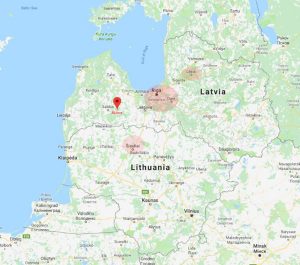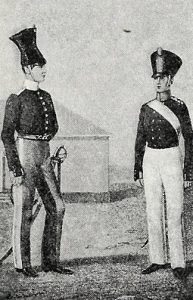Early Jewish Life in Riga, Latvia
Did Aron Bliden and his family own a mill in Riga or in Wenden? Were there other Blieden relatives who did settle in Riga? Did they just say they were from Riga since it was more commonly known than the town of Wenden?
These questions will be answered thoughout this section, while this page is devoted to general information about Riga and Wenden.
Jewish people were in Riga as early as the 13th century, but it would take more than 200 years for them to make an economic impact.

Cesis is the modern name for Wenden
In the early 14th century, the Master of the German Order ruled that Jews were banned from settling the region, but in 1561, when the Polish gained control of the territory, Jews slowly began to settle there.
In the 15th and 16th centuries, only the most prominent Jews were allowed to live in Riga, but they were still confined to Judenherberge, or special inns. They were not allowed to be buried within city limits, so Jewish dead were buried in cemeteries in Poland until 1725, when permission to build a cemetery finally came.
Russia conquered Livonia, with the city of Riga, the Baltic Port, from Sweden in 1721. Courland, formerly an autonomous duchy under Polish rule, and was annexed into Russia as a province in 1795. Both these provinces were situated outside the Pale of Settlement, and so only those Jews who could prove that they had lived there legally before the provinces became part of Russia were authorized to reside in the region.
In the 18th century, Jewish movements in the city were relaxed and Jewish residents started to appear. The first Jewish inhabitants were skilled craftsmen, making the best shoes, furs, and furniture. Scholars led the way in finance, medicine, and law. Although a fair number of Jews prospered, many others were vagrants. The Jewish community was centered in Maskavas, a ghetto just southeast of Old Town. (During World War II, the Nazis destroyed most of Maskavas, leaving few remnants of early Rigan Jewish history).
By the mid-18th century, there were still only a couple hundred Jews in Riga, most of whom came from Prussia. Haskalah (Jewish Enlightenment) made its way early to the Livonia and Courland communities, but not assimilation. The center of Latvian Jewry was formed by the Jews of Livonia (Livland) and Courland, the two principalities on the coast of the Baltic Sea .They became part Russian Empire during the 18th century,
The Jewish life in Courland had features of both East European and German Jewry. The Jews of Courland formed a special group within Russian Jewry.
In 1841 Jews were allowed to register officially as inhabitants of the city, and later were permitted to build a synagogue, own property, and engage in commerce and trade
When Latvia declared its independence, Jews formed political parties and participated as members of parliament. The Jewish community flourished. Jewish parents had the right to send their children to schools where they were taught in Hebrew.
By 1824, there were 513 Jews registered in Riga and by 1897, there were more than 20,000, which was approximately 8 percent of the population of Riga.
In the early part of the 20th century, Jews were blamed for provoking 1905 riots against Tsar Nicholas II, and again during the Bolshevik Revolution of 1917. Many Jews Left Riga at this time for foreign lands.
Early Jewish Life in Wenden, Latvia
Wenden is a town in Latvia located in the northern part of the Central Vidzeme Upland. Wenden is on the Gauja River valley, and is built on a series of ridges above the river overlooking the woods below. Today it is known as Cesis.
Venden (German for Wenden) was founded in 1200 by the Livonians (an order of Christian knights from Germany). At the end of the 18th century, Wenden was under Polish rule and was the headquarters for Lipland. In 1721 Lipland was annexed by Russia, and Wenden was proclaimed the district town in 1785.
Until the second half of the 19th century only a few Jewish traders had been granted permission to live in the town. In 1868 there were only 18 Jewish inhabitants, most of whom were cantonists (young boys, sons of conscripted Russians, who were educated in special “canton schools” for future military service) and Lithuanian Jews. By 1897 there were 368 Jews living in Wenden (6% of the total population).
Before Cantonist schools were abolished in 1857, conscripts had a six year military training and were required to serve in the Imperial Russian Army for 25 years after finishing their schooling. This amount was decreased to 20 years in 1834 and in 1855 to 12 years ply three years of reserves. Jewish boys were encouraged to convert to Orthodox Christianity while in school.

Cantonists
What made the Jewish population grow along with the town in general? The construction of the Rīga-Pskov highway (1868) and the Rīga-Valka railway line (1889) hastened the growth of the town.
Wenden was considered outside of the “Pale of Settlement”. The Pale of Settlement was the areas that Jews were allowed to live in. Only certain categories of people were given permission to live outside of the Pale.
At first, prayer services were held in a rented house but eventually a synagogue was built. The first Jews in the town were small scale merchants, peddlers and tradesmen. They lived together on the outskirts of the town.
The Jewish section of the cemetery is located in the municipal cemetery. Approximately 30 tombstones have remained standing.
Someone went through all of the Jewish family records in Cesis and compiled a list of surnames. He recognized that his list was not comiplete and that names were missing. Unfortunately, neither Bliden or Wolfson, appears on his list.
Information on this page is from:
- https://en.wikipedia.org/wiki/History_of_the_Jews_in_Latvia
- http://www.jewishvirtuallibrary.org/riga-latvia-jewish-history-tour
- https://en.wikipedia.org/wiki/Haskalah
- https://en.wikipedia.org/wiki/C%C4%93sis
- https://dbs.bh.org.il/place/cesis
- https://en.wikipedia.org/wiki/Cantonist
- https://groups.jewishgen.org/g/main/messhttps://groups.jewishgen.org/g/main/message/265993
